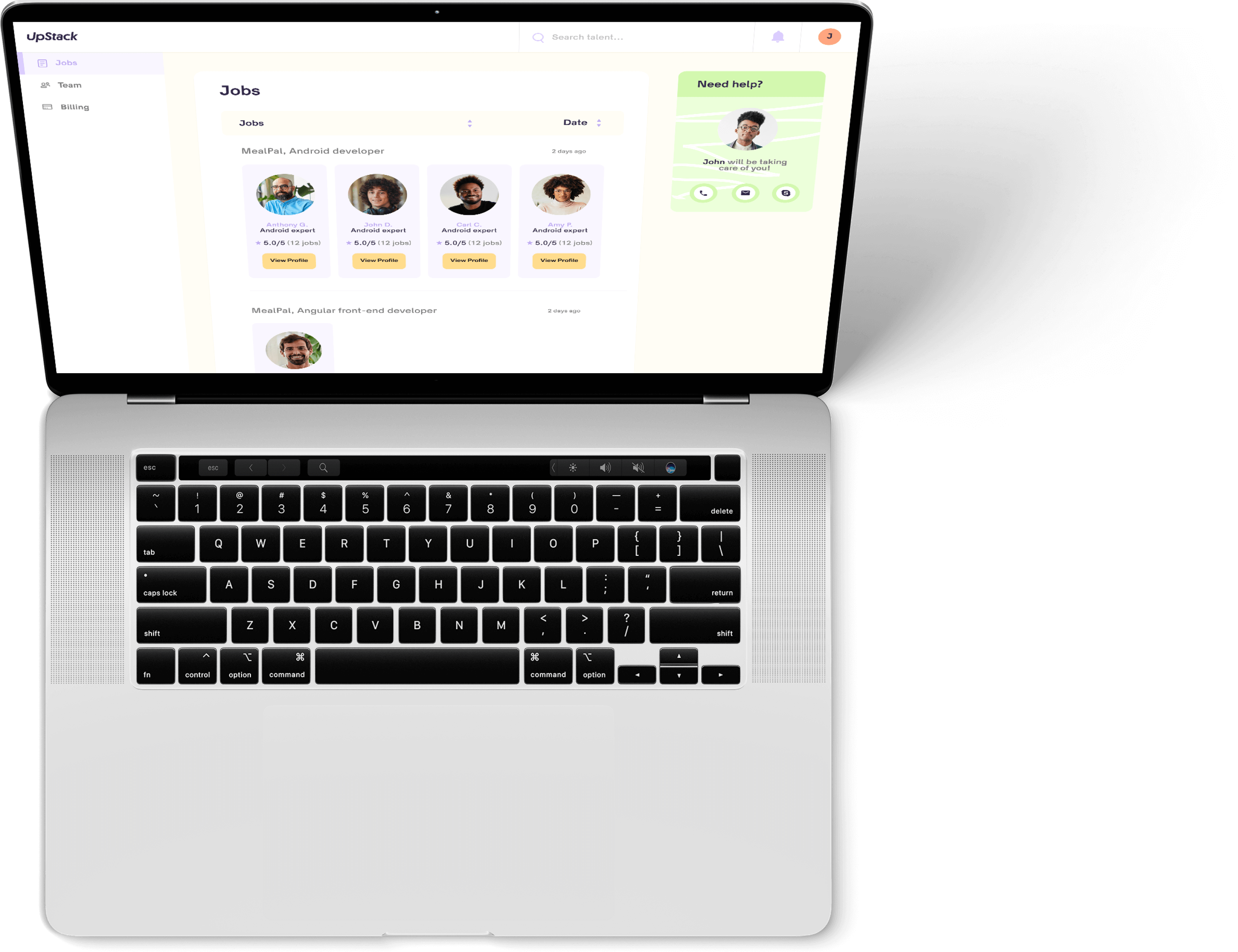


Hire AR Developers Remotely {Devs Ready!}
Stella B.
Available
Augmented Reality Developer
-
Experienced Augmented Reality engineer with seamless project implementation
-
Loves guacamole & hates spoilers

-
Marcus T.
Available
Python Engineer
-
Stacked portfolio of beautiful, functional websites
-
Known for his epic charcuterie & cheese boards

-
David M.
Available
Mobile Developer
-
Mobile engineering guru with a knack for translating stakeholder needs
-
Would rather be diving Palau’s Blue Corner

-
Top UpStack Augmented Reality Developers
Hire Augmented Reality Developers with Upstack
Augmented Reality (AR) is an exciting new technology that is revolutionizing how businesses solve problems and interact with customers. As the demand for AR developers continues to grow, hiring the right person is an essential part of any successful AR project. When looking for AR programmers, there are a few key elements to consider. First, look for someone who is passionate about AR and is up to date on the latest trends. Second, look for someone with a solid technical background who can develop well-structured, high-quality code. Third, make sure the developer is comfortable with the particular AR platform you are planning to use. Finally, look for someone who is a strong communicator and collaborator, who can work well with the rest of your team. By considering these key elements, you will be able to find the perfect AR developer for your project.
Key elements to consider when hiring AR developers
There are a few key elements to consider when hiring AR developers. First, look for someone who is passionate about AR and is up to date on the latest trends. For many developers, AR is a new technology that has the potential to disrupt many different industries. As such, many developers see AR as a promising and exciting field to be a part of. If you are hiring a programmer with no experience in AR, they will have a lot to learn before they can be effective on your project. On the other hand, hiring a programmer who is already excited about AR will make it easier to train them on the specifics of your project. Second, look for someone with a solid technical background who can develop well-structured, high-quality code. AR is a complex technology that takes a lot of effort to implement. As such, it is important to hire developers who have significant experience in developing high-quality software. Otherwise, they may struggle to implement AR correctly and on time. Make sure the developer has experience with the AR platform you are planning to use. If you are planning to build a mobile AR app, make sure your developer has experience with developing for the mobile platform you plan to use. If you are planning to build a web-based AR experience, make sure your developer is familiar with the technologies used to build web applications. Finally, make sure the developer is comfortable with the particular AR platform you are planning to use. While many developers have experience with building AR applications, not all developers are equally comfortable with each AR platform. If you plan to build a mobile AR app, make sure your developer has experience developing for the platform you plan to use. If you plan to build a web-based AR experience, make sure your developer is familiar with the technologies used to build web applications. By considering these key elements, you will be able to find the perfect AR developer for your project.
A. Passion for AR
Augmented Reality is an exciting new technology that is revolutionizing how businesses solve problems and interact with customers. As the demand for AR programmers continues to grow, hiring the right person is an essential part of any successful AR project. When looking for AR developers, start by looking for someone who is passionate about AR and is up to date on the latest trends. Finding someone who enjoys AR will make it easier for them to stay engaged on your project. It will also help them stay up to date on the latest trends, which can make it easier to anticipate future customer needs. Passionate AR developers will also want to do a great job on your project, which will help ensure that you receive a high-quality product. Finally, it will make it easier to retain your developers, as they will be happy to be working on your project.
B. Technical background
Augmented Reality is a complex technology that takes a lot of effort to implement. As such, it is important to hire developers who have significant experience in developing high-quality software. Otherwise, they may struggle to implement AR correctly and on time. Look for developers who have extensive experience developing software, ideally in a team environment. This will help ensure that your programmers have experience working with others and know how to write code that others can understand and work with easily. It is also important to look for developers who have experience with developing for the platforms you plan to use. If you plan to build a mobile AR app, make sure your developer has experience developing for the mobile platform you plan to use. If you plan to build a web-based AR experience, make sure your developer is familiar with the technologies used to build web applications.
C. Comfort with the AR platform
Augmented Reality is more than just adding visual elements to an application. It is also about understanding how a user’s environment affects their ability to engage with your app. As such, it is important to hire developers who are comfortable with the AR platform you plan to use. For example, if you plan to build a mobile AR app, make sure your developer is familiar with ARKit and ARCore. If you plan to build a web-based AR experience, make sure your developer is familiar with WebAR. Hiring developers who are already familiar with the platform you plan to use will make it easier to get your project started. It will also help ensure that your app is built in a way that maximizes the functionality of the platform.
D. Communication and collaboration skills
Communication and collaboration skills are important for any developer, but are especially critical for AR programmers. For one, AR developers need to communicate with stakeholders to understand their requirements and help them visualize how their app will look in their environment. AR devs will also need to collaborate with other developers to create their app. Communication and collaboration skills are important because they determine how easily your team members collaborate and how effectively they communicate with one another. Look for developers who come from a collaborative and open culture. This will help ensure that your team members work well together and that they understand each other’s work. Collaborative and open team members are also more likely to speak up if something is going wrong or if they need help understanding something. This can help your team avoid common pitfalls and deliver a better product.
Examples of AR developers
Augmented Reality developers can come from a wide variety of backgrounds, which makes it difficult to describe what someone in this field would look like. Some AR devs come from computer science or engineering backgrounds, while others come from creative fields like graphic design or marketing. Some developers come from a mix of these fields, while others come from completely different industries. Regardless of their background, there are some examples of AR developers that you can look to for inspiration and ideas. First, there are AR engineers. AR engineers are developers who specialize in building AR applications. This can include building mobile AR apps or building web-based AR experiences. AR engineers will likely have a computer science or engineering background, and will have a significant amount of experience building AR applications. Next, there are AR designers. AR designers are a relatively new field that combines design and AR to help businesses solve problems. AR designers will likely have a creative background, such as a graphic design or marketing background, although it is possible for them to come from fields like architecture or engineering. AR designers will have a solid understanding of design and of AR and will be able to create beautiful and functional apps.
They trust Our Augmented Reality Developers
Why hire a Augmented Reality developer with Upstack
![Augmented Reality Developer and Programmer Icon]()
Top Augmented Reality talent pre-vetted for a perfect fit.
Our 8-point assessment evaluation ensures that every senior Augmented Reality developer you interview exceeds expectations across technical, cultural, and language criteria.
![Augmented Reality Programmers Computer Icon]()
Hire reliable, passionate Augmented Reality developers.
From late-night sprints to jumping on a last-minute face-to-face, we ensure that your recruits are down to get the job done right.
![Augmented Reality Programmers High Five Icon]()
Risk-free 14-day trial.
Confidently onboard candidates with our no-questions-asked trial period. We’ll walk you through the contract-to-hire process if and when you’re ready to make it permanent with your new Augmented Reality engineer.
![Augmented Reality Computer Programmer Icon]()
Our Client Success Experts provide white-glove service.
Stay laser-focused on your business goals while our team of experts curates potential candidates and manages seamless programmer onboarding.
![Augmented Reality Developer Writing Notes Icon]()
Build your optimal team confidently, quickly.
UpStack handles everything including background and reference checks, legal issues, and more. Our platform streamlines billing, timesheets, and payment all in one easy-to-access place.
Schedule a call with a Client Success Expert to get starting hiring a Augmented Reality developer.
Start hiring Start hiring Start hiring
Hire from the Best.
Working with our Client Success Experts, we’ll help you build the remote team of your dreams with top Augmented Reality talent from around the world.
Pre-vetted, reliable Augmented Reality developers are standing by.





Hiring Augmented Reality Developers | FAQs
How much does it cost to hire a Augmented Reality developer?
UpStack has a simple billing model where each Augmented Reality developer has a standard hourly rate averaging between $65-$75 per hour. Rates are based on skills, knowledge, and experience, and our developers are available mainly for full-time engagement (40 hours per week) and the occasional part-time opportunity (20 hours per week).
What is the process to find a Augmented Reality developer?
You’ll connect with an UpStack Client Success Manager to determine your immediate needs. Our team uses a combination of AI and personal assessment to short-list candidates that match your job requirements. From there, you interview, select, and onboard the perfect developer, all within days of your initial call.
How does UpStack find its Augmented Reality developers?
UpStack’s talent recruitment team connects with software developers around the globe every day. Each Augmented Reality programmer is vetted for technical, communication, and other soft skills necessary for a developer to successfully work with your team. Once vetted, the candidates are accepted into the UpStack developer community.
How is UpStack different from an agency or recruiter?
UpStack's community of available, pre-vetted engineering talent means minimizing roadblocks to scaling your team effectively, efficiently, and immediately. Our Client Success Experts work with you and your UpStack developer to ensure a smooth and seamless engagement.
Can I hire UpStack Augmented Reality developers directly?
Yes, you can hire UpStack Augmented Reality developers at any time, and with the same assurance of smoothly on boarding talent risk-free. First, we’d create a job opening on our portal. Then, we’d vet, interview, and match developers that meet your needs. If you’re satisfied at the end of the 14-day trial period, at any time you can directly hire them.
Common FAQs about Augmented Reality
What is augmented reality?
Augmented reality (AR) is a technology that allows users to view and interact with digital content and information in the real world. Unlike virtual reality (VR), which creates a completely immersive and artificial environment, augmented reality overlays digital content and information on top of the real world, allowing users to see and interact with both the digital content and the real world at the same time.
Augmented reality can be used in a variety of applications, such as gaming, education, marketing, and entertainment. For example, an AR game might allow users to see and interact with virtual objects and characters that are superimposed on their physical environment, while an AR educational app might provide additional information and context about the real-world objects that are visible to the user.
To use augmented reality, users typically need a device that is capable of displaying the digital content and information. This can be a smartphone or tablet with a built-in AR platform, such as Apple ARKit or Google ARCore, or it can be a dedicated AR headset or device. Some common examples of AR devices include the Microsoft HoloLens, the Magic Leap One, and the Meta 2.
Overall, augmented reality is a technology that has the potential to revolutionize the way we interact with the world around us by seamlessly blending digital content and information with the real world. It offers new opportunities for education, entertainment, and communication, and it is already being used in a wide range of applications and industries.
What does the mesh do in augmented reality?
In augmented reality (AR), the mesh is a digital model of a physical space that is used to track the position and orientation of an AR device in that space. The mesh is created by scanning the physical environment with the AR device, and it is used to align the digital content and information that is displayed by the AR device with the real-world objects and surfaces that are visible to the user.
For example, when using an AR game, the mesh is used to determine the position and orientation of the AR device in the physical space, so that the virtual objects and characters can be accurately placed and rendered in the game. This allows the virtual content to appear as if it is part of the real-world environment, and it enables the user to interact with the virtual content in a natural and intuitive way.
The mesh is an important component of AR technology, as it allows AR devices to accurately track and map the physical environment and to display digital content that is correctly aligned with the real world. The mesh is typically created and updated in real-time as the user moves and interacts with the physical environment, allowing the AR experience to be dynamic and responsive.
Overall, the mesh is a key element of augmented reality, as it allows AR devices to accurately track and map the physical environment and to provide a seamless and immersive AR experience for users.
What programming language is used to create augmented reality?
There is no one specific programming language that is used to create augmented reality (AR) experiences, as AR can be implemented using a variety of different programming languages and frameworks. Some common languages and frameworks that are used for AR development include:
- C#: C# is a popular programming language that is commonly used for creating AR experiences on the Microsoft HoloLens and other AR devices that use the Unity game engine. C# is a modern and powerful language that is well-suited to the challenges of AR development, and it provides a range of tools and libraries for creating interactive and immersive AR experiences.
- JavaScript: JavaScript is a widely-used programming language that is commonly used for creating AR experiences on web-based platforms, such as Google ARCore and Apple ARKit. JavaScript is a versatile language that is supported by all modern web browsers, and it provides a range of libraries and frameworks for creating AR content that can be accessed and used on the web.
- C++: C++ is a high-performance programming language that is commonly used for creating AR experiences on mobile platforms, such as iOS and Android. C++ is a low-level language that provides fine-grained control over hardware and software resources, and it is often used for creating AR applications that require high performance and low latency.
Overall, there are many different programming languages and frameworks that can be used to create augmented reality experiences, and the best choice will depend on the specific requirements and constraints of your AR project. Some common factors that may influence your choice of programming language for AR development include the target platform, the desired performance and interactivity, and the specific features and capabilities of the AR.
Who developed augmented reality?
The concept of augmented reality (AR) has been around for many years, and it has been developed and researched by a number of individuals and organizations. Some of the key figures in the development of AR technology include:
- Ivan Sutherland: Ivan Sutherland is often credited as the father of AR, as he was the first to propose the idea of augmenting the real world with computer-generated information in his 1968 paper "The Ultimate Display". Sutherland's vision of AR was a head-mounted display that would allow users to see and interact with virtual objects and information in the real world.
- Louis Rosenburg: Louis Rosenburg is the founder and CEO of the AR technology company Meta, and he is considered to be one of the pioneers of AR technology. Rosenburg developed the first AR system, called the Desk-Top Theater, in the 1980s, and he has continued to innovate and push the boundaries of AR technology with his work at Meta.
- Tom Caudell: Tom Caudell is a researcher and inventor who is credited with coining the term "augmented reality" in 1990. Caudell was working on a project for Boeing at the time, and he used the term "augmented reality" to describe the technology that was being developed to help workers assemble aircraft wiring harnesses more efficiently.
Overall, the development of augmented reality technology has been a collaborative effort involving many individuals and organizations. While these three individuals are among the key figures in the history of AR, there have been many others who have contributed to the development and advancement of this technology.
What is the best AR headset?
In general, the best AR headset will depend on your specific needs and preferences. There are many different AR headsets available on the market, and each one has its own unique features and capabilities. Some of the factors that you may want to consider when choosing an AR headset include:
- Display quality: The quality of the display on an AR headset can have a big impact on the overall AR experience. Look for a headset with a high-resolution display and a wide field of view, as this will provide a more immersive and realistic AR experience.
- Comfort and fit: An AR headset needs to be comfortable to wear for extended periods of time, so be sure to choose a headset that fits well and is lightweight and adjustable. Consider the material and design of the headset, as well as any accessories or padding that may be included.
- Tracking and mapping: A good AR headset should be able to accurately track and map the physical environment, so that the digital content and information displayed by the headset is correctly aligned with the real world. Look for a headset that uses advanced tracking and mapping technology, such as depth sensors and motion tracking, to provide a seamless and natural AR experience.
Overall, the best AR headset will depend on your specific needs and preferences. It would be best to research the available options and compare the features and capabilities of different AR headsets to find the one that is best suited to your needs.















